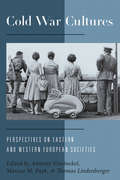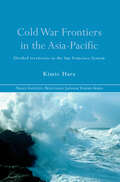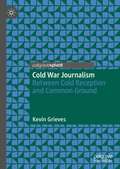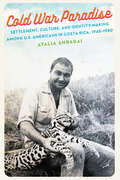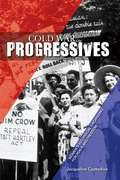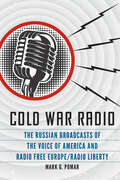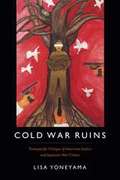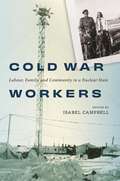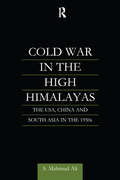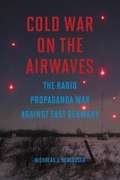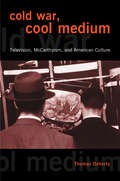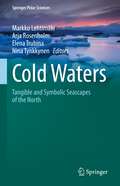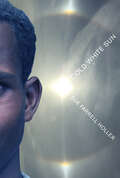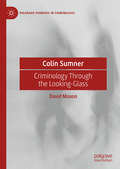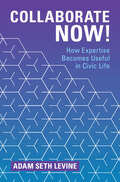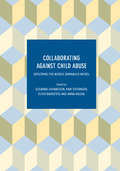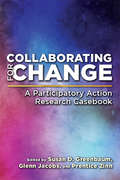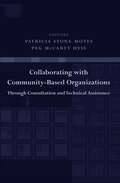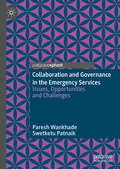- Table View
- List View
Cold War Crucible: The Korean Conflict and the Postwar World
by Masuda HajimuAfter World War II, the major powers faced social upheaval at home and anti-colonial wars around the globe. Alarmed by conflict in Korea that could change U.S.-Soviet relations from chilly to nuclear, ordinary people and policymakers created a fantasy of a bipolar Cold War world in which global and domestic order was paramount, Masuda Hajimu shows.
Cold War Cultures
by Marcus M. Payk Thomas Lindenberger Annette VowinckelThe Cold War was not only about the imperial ambitions of the super powers, their military strategies, and antagonistic ideologies. It was also about conflicting worldviews and their correlates in the daily life of the societies involved. The term "Cold War Culture" is often used in a broad sense to describe media influences, social practices, and symbolic representations as they shape, and are shaped by, international relations. Yet, it remains in question whether -- or to what extent -- the Cold War Culture model can be applied to European societies, both in the East and the West. While every European country had to adapt to the constraints imposed by the Cold War, individual development was affected by specific conditions as detailed in these chapters. This volume offers an important contribution to the international debate on this issue of the Cold War impact on everyday life by providing a better understanding of its history and legacy in Eastern and Western Europe.
Cold War Encounters in US-Occupied Okinawa
by Mire KoikariIn this innovative and engaging study, Mire Koikari recasts the US occupation of Okinawa as a startling example of Cold War cultural interaction in which women's grassroots activities involving homes and homemaking played a pivotal role in reshaping the contours of US and Japanese imperialisms. Drawing on insights from studies of gender, Asia, America and postcolonialism, Koikari analyzes how the occupation sparked domestic education movements in Okinawa, mobilizing an assortment of women – home economists, military wives, club women, university students and homemakers – from the US, Okinawa and mainland Japan. These women went on to pursue a series of activities to promote 'modern domesticity' and build 'multicultural friendship' amidst intense militarization on the islands. As these women took their commitment to domesticity and multiculturalism onto the larger terrain of the Pacific, they came to articulate the complex intertwinement of gender, race, domesticity, empire and transnationality that existed during the Cold War.
Cold War Frontiers in the Asia-Pacific: Divided Territories in the San Francisco System (Nissan Institute/Routledge Japanese Studies)
by Kimie HaraAfter World War II, many regional conflicts emerged in the Asia-Pacific, such as the divided Korean peninsula, the Cross-Taiwan Strait, the ‘Northern Territories’, (Southern Kuriles) Takeshima (Dokdo), Senkaku (Diaoyu) and the Spratly (Nansha) islands problems. These and other disputes, such as the Okinawa problem in relation to the US military presence in the region, all share an important common foundation in the post-war disposition of Japan, particularly the 1951 Peace Treaty. Signed by forty-nine countries in San Francisco, this multilateral treaty significantly shaped the post-war international order in the region, and with its associated security arrangements, laid the foundation for the regional Cold War structure, the "San Francisco System." This book examines the history and contemporary implications of the "San Francisco System," with particular focus on its frontier problems. Drawing on extensive archival research and in-depth analysis, Kimie Hara uncovers key links between the regional problems in the Asia-Pacific and their underlying association with Japan, and explores the clues for their future resolution within the multilateral context in which they originated. Cold War Frontiers in the Asia-Pacific will appeal to students and scholars interested in international relations of the Asia-Pacific region, diplomatic history and Japanese diplomacy.
Cold War Journalism: Between Cold Reception and Common Ground
by Kevin GrievesThis book explores Cold War journalism and journalists as threat, representing ‘enemy’ systems and ideologies. The book also examines Cold War aspirations of forging transnational journalistic connections across the Iron Curtain as well as finding common journalistic ground within the East and West blocs. The book shines a critical light on overly idealistic visions for that journalistic common ground, drawing on primary archival source material to investigate journalists and reporting work, journalistic content and journalistic venues during the Cold War era. This is not a book about traditional war correspondence – rather, it is about the rhetorical battles and the ideological fronts that have shaped and continue to shape our world. By fully understanding how journalism and journalists have intersected with hostile barriers and divisions in the past, we can have a more nuanced understanding of the current global media environment.
Cold War Paradise: Settlement, Culture, and Identity-Making among U.S. Americans in Costa Rica, 1945–1980
by Atalia ShragaiIn the wake of the Cold War, a diverse group of U.S. immigrants flocked to Costa Rica, distancing themselves from undesirable U.S. policies at home and abroad. Enchanted with Costa Rica&’s natural beauty and lured by the prospect of cheap land, these expatriates—former government employees, businessmen and privileged bourgeois, dissident Quakers and self-seeking hippies, farmers and ecologists—sought a new life in a country that was often dubbed the Switzerland of Central America.Cold War Paradise is a social and cultural history of this little-studied immigration flow. Based on extensive oral histories of these immigrants and their diverse writings, ranging from women&’s club cookbooks to personal letters, Atalia Shragai examines the motivations for immigration, patterns of movement, settlements, and processes of identity-making among U.S. Americans in Costa Rica from post–World War II to the late 1970s. Exploring such diverse themes as gender, nature, and material culture, this study provides a fresh perspective on inter-American relations from the point of view of ordinary U.S. emigrants and settlers. Shragai traces the formation and evolution of a wide range of identifications among U.S. expats and the varied ways they reconstructed and represented their individual and collective histories within the broader scheme of the U.S. presence in Cold War Central America.
Cold War Progressives: Women's Interracial Organizing for Peace and Freedom
by Jacqueline CastledineIn recognizing the relation between gender, race, and class oppression, American women of the postwar Progressive Party made the claim that peace required not merely the absence of violence, but also the presence of social and political equality. For progressive women, peace was the essential thread that connected the various aspects of their activist agendas. This study maps the routes taken by postwar popular front women activists into peace and freedom movements of the 1960s and 1970s. Historian Jacqueline Castledine tells the story of their decades-long effort to keep their intertwined social and political causes from unraveling and to maintain the connections among peace, feminism, and racial equality. Postwar progressive women and their allies often saw themselves as members of a popular front promoting the rights of workers, women, and African Americans under the banner of peace. However, the Cold War indelibly shaped the contours of their activism. Following the Progressive Party's demise in the 1950s, these activists reentered social and political movements in the early 1960s and met the inescapable reality that their agenda was a casualty of the left-liberal political division of the early Cold War era. Many Americans now viewed peace as a leftist concern associated with Soviet sympathizers and civil rights as the favored cause of liberals. Faced with the dilemma of working to reunite these movements or choosing between them, some progressive women chose to lead such New Left organizations as the Jeannette Rankin Brigade while others became leaders of liberal "second wave" feminist movements. Whether they committed to affiliating with groups that emphasized one issue over others or attempted to found groups with broad popular-front type agendas, Progressive women brought to their later work an understanding of how race, class, and gender intersect in women's organizing. These women's stories demonstrate that the ultimate result of Cold War-era McCarthyism was not the defeat of women's activism, but rather its reconfiguration.
Cold War Radio: The Russian Broadcasts of the Voice of America and Radio Free Europe/Radio Liberty
by Dr. Mark G. PomarCold War Radio is a fascinating look at how the United States waged the Cold War through the international broadcasting of Voice of America (VOA) and Radio Free Europe/Radio Liberty (RFE/RL). Mark G. Pomar served in senior positions at VOA and RFE/RL from 1982 to 1993, during which time the Reagan and Bush administrations made VOA and RFE/RL an important part of their foreign policy. VOA is America&’s &“national voice,&” broadcasting in more than forty languages, and is charged with explaining U.S. government policies and telling America&’s story with the aim of gaining the respect and goodwill of its target audience. During the Cold War, the VOA Russian Service broadcast twenty-four hours a day, seven days a week. RFE/RL is a private corporation, funded until 1971 by the CIA and afterward through open congressional appropriations. It broadcast in more than twenty languages of Central and Eastern Europe and Eurasia and functioned as a &“home service&” located abroad. Its Russian Service broadcast news, feature programming, and op-eds that would have been part of daily political discourse if Russia had free media. Pomar takes readers inside the two radio stations to show how the broadcasts were conceived and developed and the impact they had on international broadcasting, U.S.-Soviet relations, Russian political and cultural history, and the dissolution of the Soviet Union. Pomar provides nuanced analysis of the broadcasts and sheds light on the multifaceted role the radios played during the Cold War, ranging from instruments of U.S. Cold War policy to repositories of independent Russian culture, literature, philosophy, religion, and the arts.Cold War Radio breaks new ground as Pomar integrates his analysis of Cold War radio programming with the long-term aims of U.S. foreign policy, illuminating the role of radio in the peaceful end of the Cold War.
Cold War Ruins: Transpacific Critique of American Justice and Japanese War Crimes
by Lisa YoneyamaIn Cold War Ruins Lisa Yoneyama argues that the efforts intensifying since the 1990s to bring justice to the victims of Japanese military and colonial violence have generated what she calls a "transborder redress culture." A product of failed post-World War II transitional justice that left many colonial legacies intact, this culture both contests and reiterates the complex transwar and transpacific entanglements that have sustained the Cold War unredressability and illegibility of certain violences. By linking justice to the effects of American geopolitical hegemony, and by deploying a conjunctive cultural critique--of "comfort women" redress efforts, state-sponsored apologies and amnesties, Asian American involvement in redress cases, the ongoing effects of the U.S. occupation of Japan and Okinawa, Japanese atrocities in China, and battles over WWII memories--Yoneyama helps illuminate how redress culture across Asia and the Pacific has the potential to bring powerful new and challenging perspectives on American exceptionalism, militarized security, justice, sovereignty, forgiveness, and decolonization.
Cold War Social Science
by Hamilton Cravens Mark SoloveyFrom World War II to the early 1970s, social science research expanded in dramatic and unprecedented fashion in the United States. This volume examines how, why, and with what consequences this rapid and yet contested expansion depended on the entanglement of the social sciences with the Cold War.
Cold War Workers: Labour, Family, and Community in a Nuclear State
by Isabel CampbellWhen Canada sought to protect its borders and aid its allies during the Cold War, many people were recruited to build the emerging security state: as construction and maintenance workers, engineers, members of the armed forces, medical researchers, and research subjects. Security work transformed the lives of individuals, families, and communities in ways that were both predictable and surprising, and both beneficial and harmful; the militarization and colonization of Indigenous lives and lands was especially disruptive.The opening essays of Cold War Workers intimately portray the complicated effects of Cold War labour upon Indigenous lives. Elmer Sinclair, a residential school survivor and member of the Canadian Armed Forces, achieved equality with white men through his militarized masculinity. His more positive professional experience contrasts with those of Indigenous workers on northern radar lines, many of whom lost languages, connections to the land, and other elements of traditional cultures as they sought new skills and better employment. Diverse Indigenous experiences of Cold War security work set the scene for the second set of essays, which explore the impact of security preoccupations on marginalized groups – the study of extreme isolation through scientific experimentation on human subjects; the targeting of gay men with psychiatric labelling to enforce an idealized masculinity; and the restriction of gender mobility in the Canadian military, and the pushback from servicewomen.Cold War Workers raises questions about the influence of settler-colonial masculine institutional values on those who laboured for the Cold War state and society. By comparing the experiences of different types of workers, families, and communities, this volume reveals how race, gender, and privilege affected people in varied and sometimes unexpected ways.
Cold War in the High Himalayas: The USA, China and South Asia in the 1950s
by S. Mahmud Ali S Mahmud AliThis text examines elite-insecurity perceptions in India, Pakistan and the USA in the 1950s. The book highlights the consequent linkages in alliance-building efforts and the subsequent triangular covert collaboration against Communist China, especially along Tibet's Himalayan frontiers. This secret alliance had an unexpected fall-out on the Kashmir dispute between India and Pakistan. Lastly the book examines the divergence of Indo-Pakistani security policies along fundamental cleavages since the 1960s.
Cold War on the Airwaves: The Radio Propaganda War against East Germany
by Nicholas J SchlosserFounded as a counterweight to the Communist broadcasters in East Germany, Radio in the American Sector (RIAS) became one of the most successful public information operations conducted against the Soviet Bloc. Cold War on the Airwaves examines the Berlin-based organization's history and influence on the political worldview of the people--and government--on the other side of the Iron Curtain. Nicholas Schlosser draws on broadcast transcripts, internal memoranda, listener letters, and surveys by the U.S. Information Agency to profile RIAS. Its mission: to undermine the German Democratic Republic with propaganda that, ironically, gained in potency by obeying the rules of objective journalism. Throughout, Schlosser examines the friction inherent in such a contradictory project and propaganda's role in shaping political culture. He also portrays how RIAS's primarily German staff influenced its outlook and how the organization both competed against its rivals in the GDR and pushed communist officials to alter their methods in order to keep listeners. From the occupation of Berlin through the airlift to the construction of the Berlin Wall, Cold War on the Airwaves offers an absorbing view of how public diplomacy played out at a flashpoint of East-West tension.
Cold War, Cool Medium: Television, McCarthyism, and American Culture (Film And Culture Ser.)
by Thomas DohertyConventional wisdom holds that television was a co-conspirator in the repressions of Cold War America, that it was a facilitator to the blacklist and handmaiden to McCarthyism. But Thomas Doherty argues that, through the influence of television, America actually became a more open and tolerant place. Although many books have been written about this period, Cold War, Cool Medium is the only one to examine it through the lens of television programming. To the unjaded viewership of Cold War America, the television set was not a harbinger of intellectual degradation and moral decay, but a thrilling new household appliance capable of bringing the wonders of the world directly into the home. The "cool medium" permeated the lives of every American, quickly becoming one of the most powerful cultural forces of the twentieth century. While television has frequently been blamed for spurring the rise of Senator Joseph McCarthy, it was also the national stage upon which America witnessed—and ultimately welcomed—his downfall. In this provocative and nuanced cultural history, Doherty chronicles some of the most fascinating and ideologically charged episodes in television history: the warm-hearted Jewish sitcom The Goldbergs; the subversive threat from I Love Lucy; the sermons of Fulton J. Sheen on Life Is Worth Living; the anticommunist series I Led 3 Lives; the legendary jousts between Edward R. Murrow and Joseph McCarthy on See It Now; and the hypnotic, 188-hour political spectacle that was the Army-McCarthy hearings. By rerunning the programs, freezing the frames, and reading between the lines, Cold War, Cool Medium paints a picture of Cold War America that belies many black-and-white clichés. Doherty not only details how the blacklist operated within the television industry but also how the shows themselves struggled to defy it, arguing that television was preprogrammed to reinforce the very freedoms that McCarthyism attempted to curtail.
Cold Waters: Tangible and Symbolic Seascapes of the North (Springer Polar Sciences)
by Arja Rosenholm Elena Trubina Markku Lehtimäki Nina TynkkynenThis book addresses the Arctic and the northern regions by exploring cold waters and northern seascapes. It focuses on cultural discourses and artistic representations concerning the human experience and imagination of how the Arctic Ocean has been explored and used. It aims to assess what is specific to the northern waters vis-à-vis other sea and water areas in the world. The contextual background is provided by the fundamental shift from terra-based thinking towards aqua-based thinking, including the histories of the northern waters and the innovative ocean studies of the last decades. This book will be of interest to readers in Arctic studies and Sea and Ocean studies (including those with interests in literature, history, cultural and film studies, anthropology and politics), Environmental History and Cultural studies as well as in Russian studies. The book has been assembled with a view towards upper-level undergraduate and post-graduate students and scholars and will also be appropriate for courses in the fields mentioned above. The book will be of interest to specialists working in and with Arctic environmental issues. There is a broad array of international academic networks, environmental, governance and cultural associations outside academia whose members may also find the book of interest.
Cold White Sun
by Sue Farrell HollerA stranger-than-fiction story based on the real-life experiences of a young boy who was smuggled out of Ethiopia amid political unrest to start a new life from nothing in Calgary, Alberta.Tesfaye lives behind the safe walls of his family’s compound in Addis Ababa, Ethiopia. His father is an important man, Tesfaye goes to one of the best schools in the city, his mother and older sisters keep him fed and cared for. He and his beloved brother, Ishi, can spend their time playing soccer, racing chickens and spying on the guests — as long as they stay away from the sharp horns of the family’s goat and avoid their father’s fiery temper.When rebel forces take over the capital, life becomes more complicated. Tesfaye’s father’s cousin takes him to live in the former imperial palace, and Tesfaye becomes the most favored son. His father takes him along when he gives political speeches and distributes leaflets. It is all very exciting, even if Tesfaye doesn’t pay attention to what the leaflets actually say.And then suddenly his father is arrested, and Tesfaye’s own life is in peril. His mother sends him into hiding in her father’s village, until even that is too dangerous. Tesfaye is put in the care of a human smuggler and embarks on an uncertain, confusing and terrifying journey through Kenya, Europe and finally to Canada, where he is put on a Greyhound bus with ten dollars and instructions to stay on the bus until someone tells him to get off. You are safe now, says the smuggler. You are in Canada. This country will protect you.And so begins his new life in North America, sheltered for a while by fellow expats, threatened by the authorities, shunted from a group home to foster care. But through it all he is plagued by confusion and grief, wondering whether he will ever know what has happened to the family he left behind.Key Text Featuresauthor’s notemaphistorical contextCorrelates to the Common Core State Standards in English Language Arts:CCSS.ELA-LITERACY.RL.6.6Explain how an author develops the point of view of the narrator or speaker in a text.
Cold-Blooded: A True Story of Love, Lies, Greed, and Murder
by Carlton SmithFrom a New York Times–bestselling journalist: The story of the murder of a California attorney at the hands of the lethally cunning wife he never doubted. A wealthy and well-connected legal ace and the proud owner of a champion show horse, Larry McNabney had every reason to love his life. But when he disappeared in September 2001, his wife, Elisa, claimed he joined a cult. When Larry&’s body was found in a shallow grave three months later, Elisa was already gone. In a red convertible Jaguar, her brown hair dyed blond, Mrs. McNabney was speeding toward a new life in Florida—and a brand new identity. Who was Elisa McNabney? Beautiful, seductive, and ruthless, she had thirty-eight aliases and a rap sheet a mile long. Carlton Smith, coauthor of the true crime classic The Search for the Green River Killer, reveals one shocking surprise after another in this harrowing tale of broken vows and deadly betrayal.
Colin Sumner: Criminology Through the Looking-Glass (Palgrave Pioneers in Criminology)
by David MoxonThis book explores the work of criminologist Colin Sumner. It re-presents his arguments and ideas on Marxism, ideology, censure, deviance, crime, underdevelopment, social control and the media; situating them in their wider social context. Moxon argues that Sumner should be restored within the criminology discipline as a pioneer who has produced works of great theoretical sophistication and insight. By systematically considering Sumner’s entire output, the book shows how his thought involved a gradually deepening understanding of his core notion of ideological censure. His writing is also marked by a growing unease with the effects of late modern capitalism and the quagmire of censoriousness rife in the 21st century. This book makes clear that Sumner’s work was remarkably prescient, and his ideas may help up to make sense of complicated times.
Collaborate Now!: How Expertise Becomes Useful in Civic Life
by Adam Seth LevineThose who seek change in civic life have much in common: they each bring valuable expertise to the table and need to strategize with others about what to do. That's why new collaborative relationships between diverse thinkers are essential. Yet they're difficult to form. Collaborate Now! presents a new argument about why that is, along with tools to foster them anew. As with any form of voluntary civic engagement, these relationships require time and motivation. Yet on top of that, collaborators often start off as strangers, and are uncertain about relationality: whether they'll relate to each other in ways that are meaningful and brimming with interaction. Using case studies, field experiments, interviews, and observational data, this book provides a rich understanding of the collaborative relationships needed to tackle civic challenges, how uncertainty about relationality can produce an unmet desire for them, and actionable tools to surface and meet this desire.
Collaborating Against Child Abuse: Exploring The Nordic Barnahus Model
by Susanna Johansson Kari Stefansen Elisiv Bakketeig Anna KaldalThis book is open access under a CC BY 4. 0 license. This edited collection explores the background and implementation of the Nordic Barnahus (or 'Children's House') model - recognised as one of the most important reforms related to children who are the victims of crime in the Nordic region. This book discusses both its potential to affect change and the challenges facing it. The model was introduced as a response to a growing recognition of the need for more integrated and child-centred services for children exposed to violence and sexual abuse. In the Barnahus structure, different professions work together to ensure that victimized children receive help and treatment and that their legal rights are met. This original study is organised into four broad themes: child-friendliness, support and treatment; the forensic child investigative interview; children's rights perspectives; and interagency collaboration and professional autonomy. Each themed section includes in-depth chapters from different Nordic countries, outlining and analysing the practice and outcomes of the collaborative work engaged in by Barnahus from different perspectives. The introductory and concluding chapters offer a comparative lens useful for policy and practice implementation within the Nordic welfare state context and beyond, ensuring this book has global academic and practical appeal.
Collaborating for Change: A Participatory Action Research Casebook
by Anne Phillips Betsy Leondar-Wright Robert Elliott Nik Theodore Chris Newman Julian Matthews Tim Sieber Leontina Hormel Carl Wilmsen Natalicia R. Tracy Lisa Marie Alatorre Bilal Mafundi Ali Jennifer Friedenbach Chris Herring Tj Johnston Dilara Yarbrough Peggy Kahn Bill Hoynes Jonathan Bix Diane E. Bush Victoria Breckwich Vásquez Rich Heyman Emily Timm Pablo Alvarado Bliss Requa-Trautz Teófilo L Reyes Christina Fletes-Romo Veronica Avila Gretchen Purser Kathleen Sexsmith Fabiola Ortiz Valdez Rebecca Fuentes Carly Fox David A Gadsby Robert C Chidester Elliott Moffett Lucinda Simpson Chris Norden Janne UnderrinerAcross the U.S. immigrants, laborers, domestic workers, low-income tenants, indigenous communities, and people experiencing homelessness are conducting research to fight for justice. Collaborating for Change: A Participatory Action Research Casebook documents the stories of a dozen community-based research projects. Academics and their partners share authorship about the importance of gathering credible evidence, both for organizing and persuading. The emphasis is on community organizations involved in struggles for equality and justice. Research projects directly engage community partners in all phases of the research process. Finally, the stories capture how the research changes the roles of researchers and those being researched. The book is designed for students, but also for community organizers, social justice activists, and their research allies; it offers real stories and real projects that show how democratizing research supports social change and heightens our understanding of complex social issues.
Collaborating with Community-Based Organizations Through Consultation and Technical Assistance
by Eds. Motes Patricia Stone Peg McCartt HessCommunity groups and human service organizations are under a tremendous amount of pressure to strengthen their programs and measure the effectiveness of their work. These challenges have prompted many to seek consultation and technical assistance in order to better plan, develop, and evaluate their services and resources and be more responsive to the needs of funders and the community.In this volume, practitioners and researchers present methods and strategies for assisting and collaborating with groups and agencies serving families. Helping a community or organization involves many tasks (reaching out to the community, building leadership, developing and planning for action) and requires specialized knowledge and skills. Contributors combine a research-based, theoretical framework with practical guidance to explain this process and offer cross-cultural case studies in a wide range of settings.The book begins with a discussion of the role of the coach or capacity-building consultant and the related but distinct activities of consultation, technical assistance, and service. The value of empowerment theory, adult learning theory, and change theory, among other theories, are outlined. Special emphasis is placed on the importance of cultural competence-the need to balance diverse needs, ethical mandates, and dilemmas is crucial. The book concludes with a detailed, step-by-step guide for helping an agency or program perform a self-evaluation.Skilled consultation and assistance enable organizations to better support and strengthen families. While this book is grounded in research, it also reflects the lived experiences of each contributor and illuminates the complex yet vital role of the consultant.
Collaborating with Community-Based Organizations Through Consultation and Technical Assistance
by Peg Mccartt Hess Patricia Stone MotesIn this volume, practitioners and researchers present methods and strategies for assisting and collaborating with groups and agencies serving families. Helping a community or organization involves many tasks (reaching out to the community, building leadership, developing and planning for action) and requires specialized knowledge and skills. The contributors combine a research-based, theoretical framework with practical guidance to explain this process and offer cross-cultural case studies in a wide range of settings.
Collaboration Across Boundaries for Social-Ecological Systems Science: Experiences Around the World
by Stephen G. PerzCollaboration across boundaries is widely recognized as a vital requisite for the advancement of innovative science to address problems such as environmental degradation and global change. This book takes collaboration across boundaries seriously by focusing on the many challenges and practices involved in team science when spanning disciplinary, organizational, national and other divides. The authors draw on a shared framework for managing the challenges of collaboration across boundaries as applied to the science of understanding complex social-ecological systems.Teams working across boundaries on diverse social-ecological systems in countries around the world report their challenges and share their practices, outcomes and lessons learned. From these diverse experiences arise many commonalities and also some important differences. These provide the basis for a set of recommendations to any collaborators intending to use science as a tool to better understand social-ecological systems and to improve their management and governance.
Collaboration and Governance in the Emergency Services: Issues, Opportunities and Challenges
by Paresh Wankhade Swetketu Patnaik“Globally, emergency services are witnessing a period of unprecedented uncertainty and change caused by pressure on their budgets, reduced manpower and changing patterns of demand and service delivery. Such challenges are also having huge implications on the workforce health and wellbeing. This book is a timely, well-researched addition to improve our understanding of the governance and collaboration issues in the emergency services.”Steve McGuirk, Chairman, Warrington and Halton Hospitals Trust, Former Chief Fire Officer and CEO, Greater Manchester Fire and Rescue Service“Good governance, collaboration and sound leadership are easy qualities to take for granted in the Emergency Services. However, given the increasing complexity of the challenging political and operational environments these organisations work in, it is not reasonable to assume these qualities will always emerge as a natural phenomenon. This book is a welcome addition that provides invaluable, evidence-based insights for leaders who are seeking to raise the quality of their services for both the public and their workforce alike.”Andy Newton, Immediate Past Chair, College of Paramedics and Former Paramedic Director, South East Coast Ambulance Service NHS Trust (SECAmb)This unique text provides fresh insights and understanding of the governance and collaboration issues between emergency services in a dynamic policy and organisational environment in a global world. The book offers critical insights into the theory and rationale behind the interoperability and collaboration between the emergency services and examines in detail, important themes around trust, leadership, workforce wellbeing and resilience and professional culture(s), each having great significance for the success of the interoperability and governance agenda. The chapters cover new materials, including the research conducted by the authors and are written in a style that is easily accessible. This book caters to a wide audience of researchers, academics, students, emergency services staff, leaders and public managers, both in the UK and internationally.

